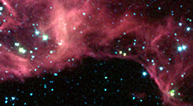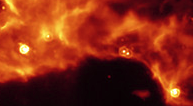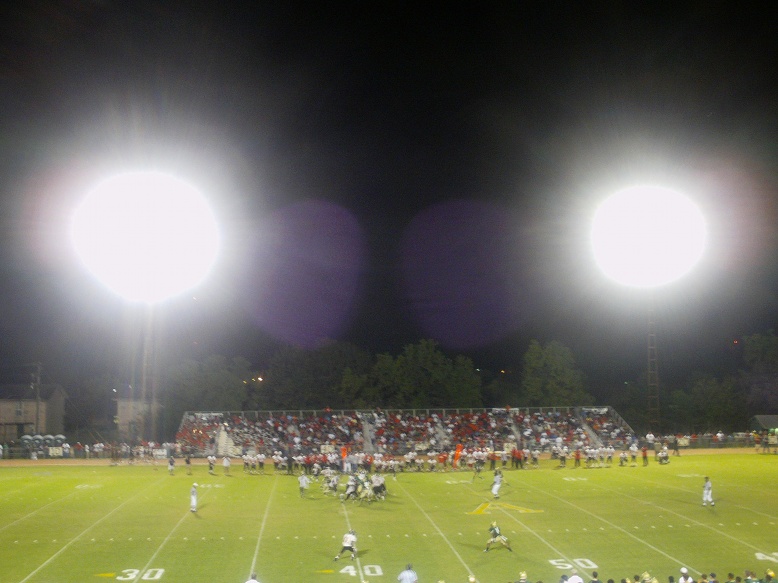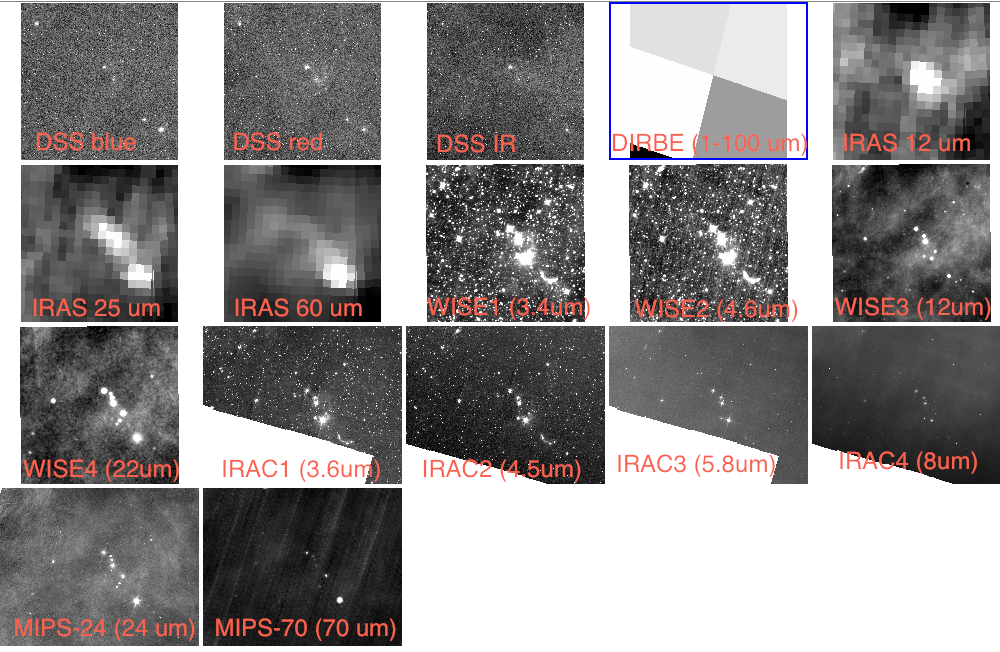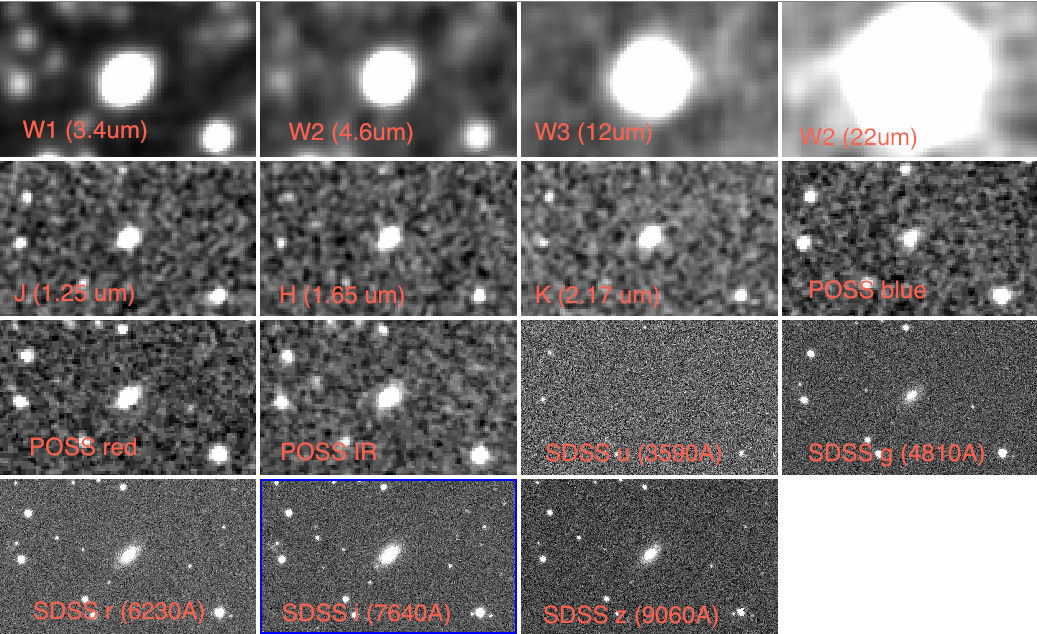Difference between revisions of "Resolution and YSOs"
m |
m |
||
| Line 14: | Line 14: | ||
You know, from your own experience, that the lights on this football field are not ''really'' gigantic fuzzy blobs with funny purple halo/shadows lurking nearby. This is just how this camera+detector responded to this lighting situation, where these lights are very bright. Same thing in the astronomical images. There are features that are just a result of how the telescope+instrument+detectors respond to a point source of light, and these features are more prominent when the source is very bright. | You know, from your own experience, that the lights on this football field are not ''really'' gigantic fuzzy blobs with funny purple halo/shadows lurking nearby. This is just how this camera+detector responded to this lighting situation, where these lights are very bright. Same thing in the astronomical images. There are features that are just a result of how the telescope+instrument+detectors respond to a point source of light, and these features are more prominent when the source is very bright. | ||
| + | |||
| + | So, the features in the Spitzer images are a result of how the telescope responds to light (and light is a wave), but not specifically pertaining to resolution per se. | ||
=Example 2.= | =Example 2.= | ||
Revision as of 01:36, 28 July 2020
Why does resolution matter to you? (specific case of YSOs)
Example 1.
We spend a lot of time in the study of YSOs talking about the rings of dust around the young stars, and how they can become more prominent at longer wavelengths. When you look at the same object as seen with IRAC and MIPS, it will seem as if the source is getting larger at MIPS, and if the source is bright, it may even look as if it has a ring around it. See example here.
These two images are of the same tiny patch of sky, the left one using IRAC and the right using MIPS. Note that there are 'rings' around some of the sources seen in MIPS. THESE ARE NOT THE DUST RINGS AROUND THESE YOUNG STARS. I cannot emphasize this enough. There are only about 10 sources close enough to the Earth such that Spitzer can actually resolve the dusty disk. (here is one, Fomalhaut.) The sources you see in the little images here are not among those 10 close-by sources. What you are seeing here is the difference in resolution between IRAC and MIPS, and the (complicated) shape of the MIPS point-spread-function (PSF, or the way that the telescope+instrument+detectors respond to a point source of light).
The best way I can think of to explain features in the PSF that do not correspond to real, physical features is in pictures like this:
You know, from your own experience, that the lights on this football field are not really gigantic fuzzy blobs with funny purple halo/shadows lurking nearby. This is just how this camera+detector responded to this lighting situation, where these lights are very bright. Same thing in the astronomical images. There are features that are just a result of how the telescope+instrument+detectors respond to a point source of light, and these features are more prominent when the source is very bright.
So, the features in the Spitzer images are a result of how the telescope responds to light (and light is a wave), but not specifically pertaining to resolution per se.
Example 2.
When you are trying to match the same source across multiple bands, resolution matters. The apparently single point source that you see at 160 microns (or some other band, if you're grabbing non-Spitzer data from somewhere) may in fact combine flux from more than one source which is seen at IRAC bands. You have to be very careful in how you match up sources, assign flux matches for constructing SEDs, and/or apportion flux between two unresolved sources. For example, in theory, if there were two sources within the 160 um beam, you could put some fraction of the 160 micron flux to one source and some fraction to the other source within the beam. But what if the two sources are not the same brightness at 24 microns but they are at 8 microns? How do you decide how much of the 160 um flux to assign to one of the sources? These are complicated issues, and you need to investigate them for the sources you care about, and see if you need to worry about this for your objects.
Here is an example. The tiles are 3.6, 8, 24, 70, and 160 microns. Who gets that 70 micron flux? There's a 160 um flux there too but the PSF is bigger than the field of view. For that matter, who gets some of those 24 um fluxes? Ack!
Example 3.
When you are trying to find archival data for the same source, resolution matters. The apparently single point source that you see in your current data may not be appropriate to match to someone's catalog from 15 years ago. Catalogs created from images whose provenance you don't know should be used with caution. You should always try to put eyeballs on the original images if you can (not always possible).
Here is the same little patch of sky at POSS (blue, red, IR), COBE/DIRBE (some sort of combination of 1-100 um scans; yes, those are pixels), IRAS (12, 25, 60), WISE (3.4, 4.6, 12, 22 um), Spitzer (3.6, 4.5, 5.8, 8, 24, 70 um). Look how much the resolution matters. This is 2 point sources in the IRAS catalog (in some bands, you see only one source -- look at the location of the source at 12 compared to 60 -- this is not the same source!). The extended emission in the lower right at WISE is a much different shape than with Spitzer at comparable wavelengths.
Example 4.
What if you find a cool source that has the right colors to be a young star, and it seems to be a point source at all the bands you have? What if we go and check it in other bands? Guess what I'm gonna say: resolution matters. Here is a real-life example. This object was detected at WISE bands 1, 2, 3, and 4 (3.4, 4.6, 12, and 22 microns), and I found it as having the right colors to be a YSO. The first thing to notice is how the resolution changes when you go even from 12-22 microns, much less 3.4 to 22 microns. This is all on the same RA/Dec scale (e.g., the size of each tile in arcseconds is the same). Just stare at those four for a while. The rest of the tiles here are the same object, on the same scale, seen at 2MASS (JHK), POSS (blue, red, IR), and Sloan (ugriz). What was a point source to WISE is very clearly a nice little elliptical galaxy once you see it in SDSS (though, given its colors, it is probably not Elliptical, in the galaxy classification sense, but most likely it's an edge-on spiral with star formation going on). My color selection is successfully finding star formation, just not star formation here in our galaxy. (if you want to investigate this guy yourself, it's ra=76.8637916667, dec=25.51377778)
Example 5.
This one is a real exercise, in that you will need to go retrieve data, examine it, and think about it. In the CG4/Sa101 paper (Rebull et al. 2011, arXiv 1105.1180), we rejected source 073355.0-464838 as a YSO candidate because the flux density seen at 24 microns is likely contaminated by a nearby source at 8 um. Can you see this source in the images? Do you see why we dropped it? Should we have kept it?
